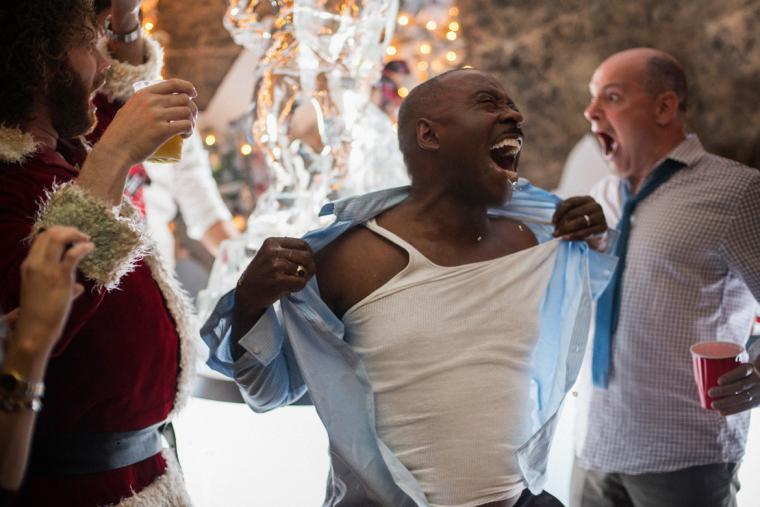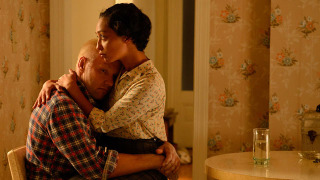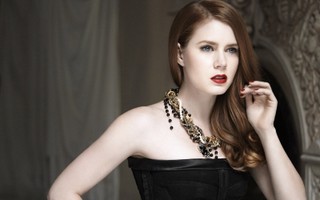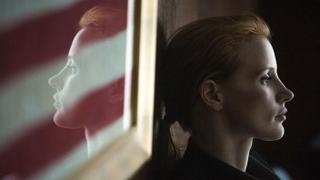
OFFICE CHRISTMAS PARTY
Is any movie sight more incongruously dull than that of amped-to-11 crowds drinking and dancing and losing their minds at a raucous on-screen party? I ponder this every time I yawn during a teen-centric Project X or a “We’re still vital, damn it!” slapstick lament such as the Tina Fey/Amy Poehler Sisters; characters may be having an inhibition-busting ball, but watching them from the immobility of a cineplex seat is a strange and alienating affair. Exactly how are we supposed to react to all these happy lunatics enjoying the techno-thumping, strobe-flashing times of their lives? By punching our fists in the air and shouting, “F--- yeah!!!”? By whipping out our own Jell-O shots and Slip N Slides? By smiling politely, chuckling occasionally, and kind of wishing we were anywhere else instead?
The latter, at least, was my general response to Office Christmas Party. Never mind the plot, which finds a Scrooge-like CEO threatening to liquidate her brother’s Chicago computer company unless he secures a major client by day’s end. (The only things separating the film from a Muppet movie are the cursing, nudity, and complete absence of Muppets.) Directors Josh Gordon’s and Will Speck’s outing is really just an excuse to assemble a team of first-rate TV comedians – plus a class-act outlier in Courtney B. Vance – for some cuh-ra-a-a-azy holiday-themed exploits and predictable sentiment, with raunchy gags aplenty and even the token Grinch learning to appreciate The True Meaning of Christmas. Which, in this particular universe, means the miracle of uninterrupted, high-speed Internet service. Just like in biblical times.

I don’t know if it was intentional, but I did somewhat admire Gordon and Speck for making the proceedings so closely resemble an actual office Christmas party – not in the accumulating, apocalyptic debris that suggests Children of Men or The Road, but in the invited guests all behaving just the way you’ve been conditioned to anticipate. Jason Bateman is every wry, put-upon, fundamentally decent lead he’s played since Arrested Development. This being a Bateman comedy, Jennifer Aniston is a horrible boss. T.J. Miller is a sweetly profane man-child. Rob Corddry is an invective-spewing blowhard. Kate McKinnon is unclassifiably strange. Jillian Bell is almost stranger. Olivia Munn is brunette, pretty, and nondescript. (Here, at least, she’s also trying to be Aubrey Plaza.) There are others, lots and lots of others, and what’s most frustrating about Office Christmas Party is that so few of them are allowed to surprise us. I mean, I want to see a coked-up Vance screaming with joy and attempting a Tarzan swing from Christmas lights as much as anyone. But did those really need to be the movie’s high points – especially when, like most of the film’s finest moments, they were already spoiled in the previews? (Viewers often worry that trailers for hilarious-seeming comedies give away all the best laughs in advance. In this film’s case, the trailers unfortunately, definitely do.)
If you like the people you work with, the movie can, admittedly, sometimes be as pleasant as a company holiday bash, just for the chance to see friendly faces outside of work mode. Vanessa Bayer and Randall Park are amusing as a traumatically single mom and her closet-fetishist crush, and Karan Soni is a constant grin as a virginal I.T. nerd who can’t stop boasting about his girlfriend who lives in Canada. (That’s a euphemism, but you get the idea.) Aniston and Miller make an unexpectedly great team of warring sibs, with their mutual hostility feeling genuinely earned. And while I could count the genuine cackles I unleashed on the fingers of one hand, at least three of them were courtesy of McKinnon, who continues to prove herself a sketch-character comedienne of almost uncharted invention. But while the Don Draper and Dominic Toretto references are clever and the ice-sculpture “eggnog luge” almost staggeringly filthy, Office Christmas Party still emerges as a bland slice of fruitcake featuring loads of nuts but no real flavor. It’s ho-ho-hum.

LOVING
Even though, refreshingly, it isn’t preceded by any kind of “The following is a true story” title card, you couldn’t mistake writer/director Jeff Nichols’ Loving for anything but a true story. As it explores the lives of accidental activists Richard and Mildred Loving – a mixed-race couple who, in 1958, were imprisoned when their marriage was deemed illegal under Virginia law – Nichols’ drama is nothing if not attentive to period and emotional detail. Its scenes of the rural South feel as acutely drawn as the clear affection in the faces and body language of stars Joel Edgerton and Ruth Negga, and the movie is effortlessly touching, thoughtful, and sincere. It’s also just a teensy-weensy bit boring. I saw the film in Chicagoland during the Thanksgiving break, but I actually heard a most telling description of the experience this past Friday, when a local Loving screening let out just as I was entering another auditorium. “What did you think?” asked the late-middle-aged man of his companion. “Well, it’s based on a true story,” she answered, seemingly by way of defense. “But it felt so long.”
Even though Nichols’ latest only lasts two hours, it does feel long, partly because there are three or four endings when one would suffice. But the bigger issue, for me, is that Loving is just too low-key for its own good. I applaud Nichols for mostly eschewing melodrama; even when the Lovings are torn from their beds in the middle of the night and hauled off to jail, the sequence is legitimately startling rather than histrionic. And Heaven knows that the leads play their roles close to the vest, with Edgerton’s heartache captured mostly through a disciplined series of shrugs and mumbles, and Negga’s silent-movie eyes conveying all you need to know about Mildred’s wariness, fear, tenacity, and hidden reserves of strength. (It’s entirely possible that your memories of the film will prove inseparable from your memories of Ruth Negga’s face.) Right before the end credits roll, however, Nichols presents us with a snapshot of the actual Lovings as taken for Life magazine – a photo of the pair watching television and enjoying a hearty laugh, with Richard’s head resting in Mildred’s lap. The shooting of this photo is indeed a scene in the film, with a charming Michael Shannon cast as the Life photographer who gains the couple’s trust. Yet in the days and weeks since I saw Loving, that photo has haunted me more and more, because I can’t get around the fact that the real-life people in that picture exude more spontaneity than Edgerton and Negga ever do – and more than Loving itself ever does.
This is a very careful movie. With the exception of its rather manipulative bit in which one of the Lovings’ children runs into traffic – a moment meant to prove how vital it is that the family returns to Virginia after being bullied into New York residence – scenes here play out with gentle, unhurried calm even when events are at their most dramatic. And barring the bizarre, if somewhat endearing, broad-comedy turn by Nick Kroll as a neophyte ACLU lawyer, the actors perform with maximum earnestness and the barest minimum of hand-wringing. Yet as the film progresses, Nichols’ care starts to feel uncomfortably close to timidity – like he’s going out of his way to resist raising viewers’ collective blood pressure. The racism behind the Lovings’ struggles, and those of the similarly disenfranchised, is angering and offensive, but those don’t seem to be reactions Nichols is going for. Instead, his is almost a docu-drama approach, with Nichols saying, “This happened” – as opposed to “How could this have happened?!” And while there’s definite integrity behind that decision, what results in Loving, sadly, is a staid and overly respectful experience – a movie to admire rather than love, or even much care about. It resembles that Life photo accurately enough, but life – messy, chaotic, hateful, thrilling, complicated life – is also what’s too often missing.

NOCTURNAL ANIMALS
If you can survive the opening credits – a slow-motion fantasia of morbidly obese naked women defiantly gyrating as part of an über-pretentious L.A. art exhibit – you should have no trouble making it through the rest of writer/director Tom Ford’s mystery/thriller Nocturnal Animals. Whether you’ll want to is another matter entirely.
Roughly half the film consists of gallery owner Amy Adams reading the manuscript for her ex-husband’s soon-to-be-published potboiler, a novel so upsetting that it causes poor Amy to routinely throw the pages to the floor and take long baths and showers to cleanse herself of its effects. The other half is the potboiler itself played out on-screen, with its tormented protagonist – a dead-ringer for the gallery owner’s ex (Jake Gyllenhaal) – seeking revenge after a nightmarish encounter on a west-Texas highway. I don’t know what it means that the novel’s fictional circumstances and characters are, in every conceivable way, infinitely more believable than the ceaseless parade of art-flick tableaux and art-world grotesques populating Adams’ “real” world. (With Armie Hammer and Michael Sheen borderline-human at best, Jena Malone drops in as a freakishly costumed Edna Mode, and Andrea Riseborough looks just like Andrea Martin if the latter guested on Absolutely Fabulous.) Then again, I’m not sure what any of Nocturnal Animals means. You keep watching because you’re curious about how the narrative’s disparate halves will reconcile themselves, and individual scenes, such as that highway horror and Gyllenhaal’s nighttime car drive with Karl Glusman, boast some gripping intensity. There are also smart thematic flourishes on the natures of guilt and forgiveness, plus a few relaxed flashbacks involving Adams’ and Gyllenhaal’s marriage, and a beauty of a five-minute turn by a magisterial Laura Linney. None of it is enough. The movie keeps shifting between fastidiously designed scenes of emotional paralysis and under-plotted scenes of Texas-style retribution involving an insufferably hammy Aaron Taylor-Johnson; and with Adams and Gyllenhaal over-directed to the hilt, the only thing that continually holds your interest is the occasional presence of Michael Shannon. Playing a stalwart law official with ease, control, hard-won authority, and the film’s sole nods to humor, the performer is marvelous here, just as he is – for an even briefer time – in Loving. Nocturnal Animals reminds us that modern movies get a lot of things wrong, but giving us too much Michael Shannon has rarely been among them.

MISS SLOANE
Between Amy Adams and Jessica Chastain, who stars in the new political thriller Miss Sloane, it was quite the weekend for alabaster-skinned, auburn-haired female leads with blood-red lipstick and severely parted coifs. I had way more fun at Chastain’s movie, and “fun” is hardly the word you expect to use when confronted with the tale of a Washington lobbyist fighting for stricter gun-control laws. Yet Miss Sloane isn’t just fun. I’d go so far as to call it a blast – a beautifully paced, delightfully verbose, enjoyably vicious throwaway that’s like one of those many John Grisham adaptations from the mid-’90s, albeit with juicier twists and a more ruthless central character. I entered director John Madden’s outing knowing almost nothing about it (previews have seemed all but nonexistent), and that might be the best way to enjoy the experience without expecting more, as there are a few manipulative detours and awfully contrived contrivances the film would have been better without. But if it’s not too late to catch the film before the Star Wars offshoot inevitably gobbles up its screens, I’d recommend seeing it for the Sorkin-esque thrill of screenwriter Jonathan Perera’s dialogue, the delicious deviousness of the sparring lobbyists, and the sensationally fierce talents of ensemble players Sam Waterston, Michael Stuhlbarg, Alison Pill (all Sorkin veterans), Gugu Mbatha-Raw, Mark Strong, John Lithgow, Dylan Baker, and that human teddy bear – here an intimidatingly buff teddy bear – known as Jake Lacy. Mostly, see it for Chastain, who gives her most thoroughly exciting screen performance since her film heyday of 2011-12, and who makes the brutal, brilliant, unforgettable Miss Sloane someone you can’t get enough of, even if you’re relieved that you’ll never have to meet her in daily life. I rarely quote other critics in my reviews, but I also don’t think that I, or anyone, could top the San Francisco Chronicle’s Mick LaSalle in his recent tweet: “Chastain takes the title role of #MISSLOANE by the throat, smashes it against the wall 10X, and then devours it while it’s still quivering.” I’ll have what she’s having.










